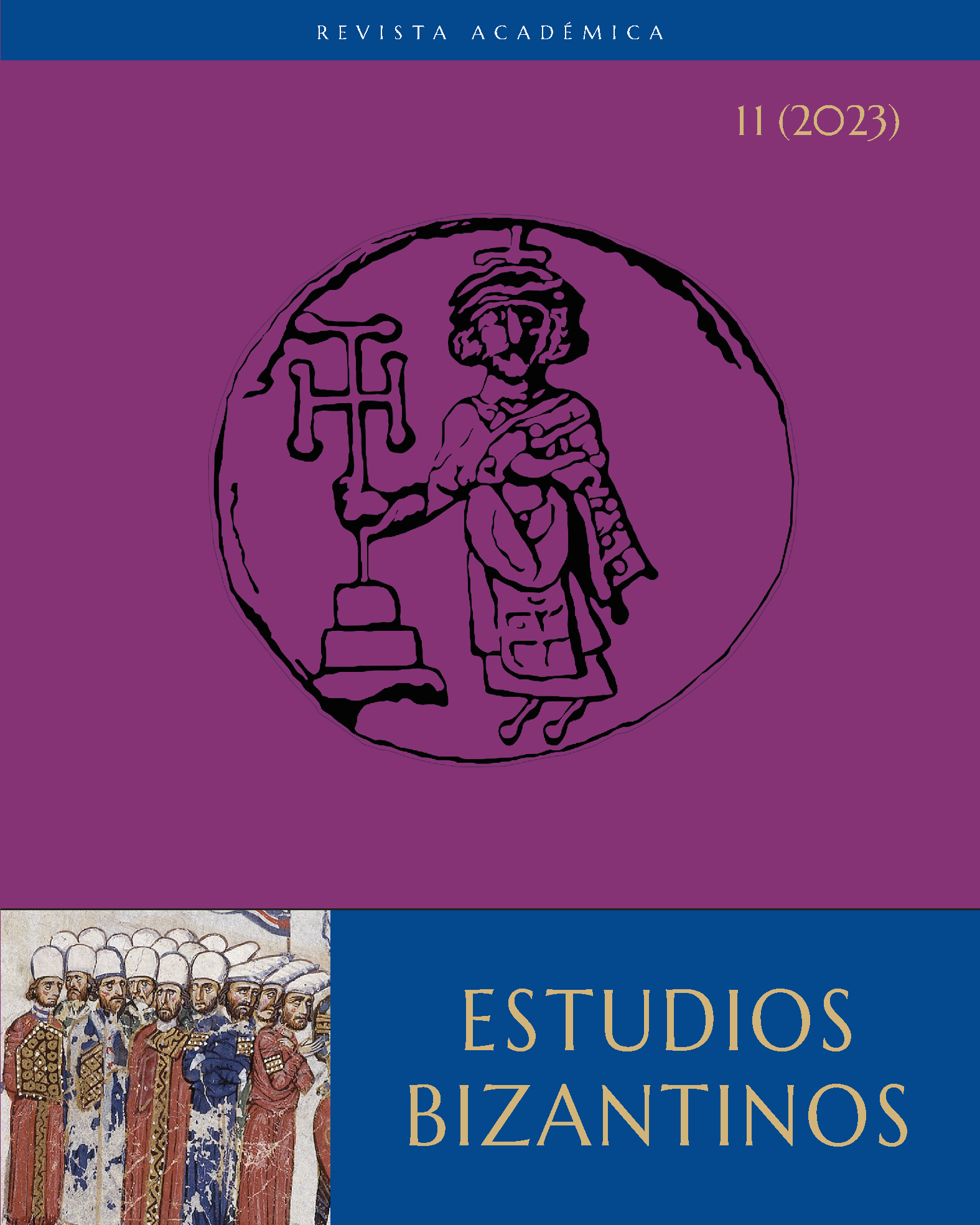Ornament and Status: Three Early Palaeologan Illuminated Manuscripts
DOI:
https://doi.org/10.37536/ebizantinos.2023.11.2393Palabras clave:
Epithalamion Vaticano, Paleografía, Manuscritos iluminadosResumen
El ‘Epithalamion Vaticano’ (BAV Vat. gr. 1851) ha sido ahora fechado por Peter Schreiner en 1271 o 1272. En este artículo presentamos un argumento adicional para su datación comparando las letras iniciales zoomorfas del Epithalamion con las encontradas en otros dos códices fechables en el reinado de Miguel VIII Paleólogo: un libro del Evangelio (Monte Athos, Monasterio de Iviron, 5) y un Salterio (Jerusalén, Biblioteca Patriarcal Griega, Παναγίου Τάφου 51). Esta comparación sugiere también que el ornamento zoomorfo funcionó en ese momento como un marcador de estatus social.
Descargas
Citas
Anderson, J. C. 1991, “The Illustrated Sermons of James the Monk: Their Dates, Order, and Place in the History of Byzantine Art”, Viator 22, 69-120.
Boojamra, J. L. 1993, The Church and Social Reform: The policies of the Patriarch Athanasios of Constantinople, New York.
Buchthal, H./Belting, H. 1978, Patronage in Thirteenth-Century Constantinople: An Atelier of Late Byzantine Book Illumination and Calligraphy (Dumbarton Oaks Studies 16), Washington DC.
Bender, L./ Parani, M./ Pitarakis, B./ Spieser, J.-M./ Vuilloud, A. ByzAD: Artefacts and Raw Materials in Byzantine Archival Documents / Objets et matériaux dans les documents d’archives byzantins, on-line at http://typika.cfeb.org.
Ćurčić, S. 1995, “Some Uses (and Reuses) of Griffins in Late Byzantine Art”, in D. Mouriki (ed.), Byzantine East, Latin West: Art-Historical Studies in Honor of Kurt Weitzmann Princeton, 597-604.
Cutler, A. 1984, The Aristocratic Psalters in Byzantium (Bibliothèque des Cahiers archéologiques 13), Paris.
Galavaris, G. 2002, Holy Monastery of Iveron: The Illuminated Manuscripts, Mount Athos.
Hilsdale, C. J. 2005, “Constructing a Byzantine Augusta: A Greek Book for a French Bride”, Art Bulletin 87, 458-483.
Huber, P. 1980, Heilige Berge: Sinai, Athos, Golgotha - Ikonen, Fresken, Miniaturen, Zurich.
Iacobini, A. 1995, “L’epitalamio di Andronico II. Una cronaca di nozze della Costantinopoli Paleologa”, in Iacobini, A. / Zanini, E. (eds.), Arte profana e arte sacra a Bisanzio (Milion: Studi e ricerche d’arte bizantina 3), Rome, 361-410.
Kitzinger, E. 1963 “Some Reflections on Portraiture in Byzantine Art”, ZRVI 8, 185-193; repr. in id.1976, The Art of Byzantium and the Medieval West: Selected Studies, Bloomington.
Konstantinos D. et al. 2004, The World of the Byzantine Museum, Athens.
Loeschke, W. “Griff ans Handgelenk”, in Wessel K. (ed.), Reallexikon zur byzantinischen Kunst, II, Stuttgart 1971, 940-944.
Macrides R. et al. 2013, Pseudo-Kodinos and the Constantinopolitan Court: Offices and Ceremonies, Farnham.
Maxwell, K. 1983, “Another Lectionary of the ‘Atelier’ of the Palaiologina, Vat. gr. 352”, DOP 37, 47-58.
Maxwell, K. 2014, Between Constantinople and Rome: An Illuminated Byzantine Gospel Book (Paris Gr. 54) and the Union of Churches, Burlington (VT).
Millet, G. 1911, “Portraits byzantins”, Revue de l’art chrétien 11, 445-451.
Nelson, R. S. - Lowden, J. 1991, “The Palaeologina Group: Additional Manuscripts and New Questions”, DOP 45, 59-68.
Nicholas, N. 1999, “A Conundrum of Cats: Pards and Their Relatives in Byzantium”, GRBS 40 253-298.
Parani, M. 2007, “Cultural Identity and Dress: The Case of Late Byzantine Ceremonial Costume”, JÖB 57, 95-134.
Pelekanidis S. et al. 1975, The Treasures of Mount Athos: Illuminated Manuscripts, II, Athens.
Pérez Martín, I. 2019, “Mi gran boda bizantina: el epitalamio ilustrado del Vat. gr. 1851”, Boletín de la Sociedad Española de Bizantinística 33, 6-11.
Prato, G. 1979, “Scritture librarie arcaizzanti della prima età dei Paleologi e loro modelli”, Scrittura e civiltà 3, 151-193.
Rhoby, A. 2018, “Hunde in Byzanz, in Drauschke J. et al. (eds.), Lebenswelten zwischen Archäologie und Geschichte: Festschrift für Falko Daim zu seinem 65. Geburtstag (Monographien des RGZM 150), Mainz, 807-820.
Rhoby, A./Stefec, R. 2018, Ausgewählte byzantinische Epigramme in illuminierten Handschriften: Verse und ihre “inschriftliche” Verwendung in Codices des 9. bis 15. Jahrhunderts (Veröffentlichungen zur Byzanzforschung 42), Vienna.
Schreiner, P. 2019, “Anna von Frankreich (1180) oder Anna von Ungarn (1272)? Historische und prosopographische Anmerkungen zum illustrierten Brautgedicht im Vaticanus gr. 1851”, in E. Juhász (ed.), Byzanz und das Abendland VI: Studia Byzantino Occidentalia (Antiquitas - Byzantium - Renascentia 38), Budapest, 81-108.
Soteroudes, P. 1998, Ἱερὰ Μονὴ Ἰβήρων: Κατάλογος ἑλληνικῶν χειρογράφων, I, Mount Athos.
Spatharakis, I. 1976, The Portrait in Byzantine Illuminated Manuscripts (Byzantina Neerlandica 6), Leiden.
Strzygowski, J. 1901, “Das Epithalamion des Paläologen Andronikos II.”, BZ 10, 546-567.
Tsamakda, V. 2023, “Die Illustrationen des Vat.gr.1851 und ihr Verhältnis zum Text”, Studi e testi (forthcoming).
Vocotopoulos, P. L. 2002, Byzantine Illuminated Manuscripts of the Patriarchate of Jerusalem, Athens-Jerusalem.
Weitzmann, K. 1957, “Eine Pariser-Psalter-Kopie des 13. Jahrhunderts auf dem Sinai”, JÖB 6 125-143.
Descargas
Publicado
Cómo citar
Número
Sección
Licencia
Derechos de autor 2023 Georgi Parpulov

Esta obra está bajo una licencia internacional Creative Commons Atribución-NoComercial-CompartirIgual 4.0.
Usted es libre de:
- Compartir — copiar y redistribuir el material en cualquier medio o formato
- Adaptar — remezclar, transformar y crear a partir del material
Bajo las condiciones siguientes:
-
Reconocimiento — Debe reconocer adecuadamente la autoría, proporcionar un enlace a la licencia e indicar si se han realizado cambios<. Puede hacerlo de cualquier manera razonable, pero no de una manera que sugiera que tiene el apoyo del licenciador o lo recibe por el uso que hace.
-
NoComercial — No puede utilizar el material para una finalidad comercial.
-
CompartirIgual — Si remezcla, transforma o crea a partir del material, deberá difundir sus contribuciones bajo la misma licencia que el original.




